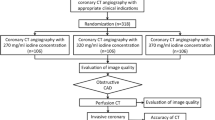Abstract
Cardiac computed tomography (CT) is a noninvasive imaging test that requires the use of intravenously administered contrast material and high-resolution, high-speed CT machinery to obtain detailed volumetric images of cardiac anatomy, coronary circulation, and great vessels. Most contrast-enhanced CT examinations in the West are performed with nonionic iodinated contrast media. However, adverse events still exist and consist of allergylike contrast reactions, chemo- or osmotoxic contrast reaction, contrast media-induced nephropathy, injection-related adverse events, and complications due to various coexisting conditions. Identification of patients at risk for developing contrast media reactions is likely to prevent serious adverse events and to enhance safety. Likewise, appropriate management strategies can be adopted to reduce morbidity and mortality associated with adverse reactions of iodinated contrast media used in cardiac CT scanning.
Access this chapter
Tax calculation will be finalised at checkout
Purchases are for personal use only
Preview
Unable to display preview. Download preview PDF.
Similar content being viewed by others
References
McClennan BL, Stolberg HO. Intravascular contrast media: ionic versus nonionic-current status. Radiol Clin North Am. 1991;29:437–454.
Spencer CM, Goa KL. Iodixanol: a review of its pharmacodynamic and pharmacokinetic properties and diagnostic use as an x-ray contrast medium. Drugs. 1996;52:899–927.
Maddox TG. Adverse reactions to contrast material: recognition, prevention, and treatment. Am Fam Physician. 2002;66:1229–1234.
Cohan RH, Ellis JH. Iodinated contrast material in uroradiology. Choice of agent and management of complications. Urol Clin North Am. 1997;24:471–491.
Mortelé KJ, Oliva MR, Ondategui S, Ros PR, Silverman SG. Universal use of nonionic iodinated contrast medium for CT: evaluation of safety in a large urban teaching hospital. AJR Am J Roentgenol. 2005;184:31–34.
Cohan RH, Matsumoto JS, Quagliano PV. Committee on Drugs and Contrast Media. Manual on Contrast Media. 5th ed. Reston, VA: American College of Radiology; 2004.
Webb JA, Stacul F, Thomsen HS, Morcos SK. Members of the Contrast Media Safety Committee of the European Society of Urogenital Radiology. Late adverse reactions to intravascular iodinated contrast media. Eur Radiol. 2003;13:181–184.
ESUR-European Society of Urogenital Radiology Contrast Media Safety Committee. Guidelines on Contrast Media. Version 4.0. 2004.
Tublin ME, Murphy ME, Tessler FN. Current concepts in contrast media-induced nephropathy. AJR Am J Roentgenol. 1998;171:933–939.
Morcos SK, Thomsen HS, Webb JA. Contrast-media-induced nephrotoxicity: a consensus report. Contrast Media Safety Committee, European Society of Urogenital Radiology (ESUR). Eur Radiol. 1999;9:1602–1613.
Ashley JB, Millward SF. Contrast agent-induced nephropathy: a simple way to identify patients with preexisting renal insufficiency. AJR Am J Roentgenol. 2003;181:451–454.
Morcos SK. Contrast media-induced nephrotoxicity-questions and answers. Br J Radiol. 1998;71:357–365.
Thomsen HS. Guidelines for contrast media from the European Society of Urogenital Radiology. AJR Am J Roentgenol. 2003;181:1463–1471.
Waybill MM, Waybill PN. Contrast media-induced nephrotoxicity: identification of patients at risk and algorithms for prevention. J Vasc Interv Radiol. 2001;12:3–9.
Bostom AG, Kronenberg F, Ritz E. Predictive performance of renal function equations for patients with chronic kidney disease and normal serum creatinine levels. J Am Soc Nephrol. 2002;13:2140–2144.
Guru V, Fremes SE. The role of N-acetylcysteine in preventing radiographic contrastinduced nephropathy. Clin Nephrol. 2004;62:77–83. Review.
Sandler CM. Contrast-agent-induced acute renal dysfunction-is iodixanol the answer? N Engl J Med. 2003;348:551–553.
Erdogan A, Davidson CJ. Recent clinical trials of iodixanol. Rev Cardiovasc Med. 2003; 4(suppl 5):S43–S50.
Tadros GM, Malik JA, Manske CL, et al. Iso-osmolar radio contrast iodixanol in patients with chronic kidney disease. J Invasive Cardiol. 2005;17:211–215.
Bellin MF, Jakobsen JA, Tomassin I, et al. Contrast Media Safety Committee of the European Society of Urogenital Radiology. Contrast medium extravasation injury: guidelines for prevention and management. Eur Radiol. 2002;12:2807–2812.
Johansen JG. Assessment of a non-ionic contrast medium (Amipaque) in the gastrointestinal tract. Investigative Radiology. 1978;13:523–527.
Raisanen J, Shapiro B, Glazer GM, et al. Plasma catecholamines in pheochromocytoma: effect of urographic contrast media. AJR Am J Roentgenol. 1984;143:43–46.
Mukherjee JJ, Peppercorn PD, Reznek RH, et al. Pheochromocytoma: effect of nonionic contrast medium in CT on circulating catecholamine levels. Radiology. 1997;202: 227–231.
Van Der Molen AJ, Thomsen HS, Morcos SK. Effect of iodinated contrast media on thyroid function in adults. Eur Radiol. 2004;14:902–907.
Rao VM, Rao AK, Steiner RM, et al. The effect of ionic and nonionic contrast media on the sickling phenomenon. Radiology. 1982;144:291–293.
Losco P, Nash G, Stone P, Ventre J. Comparison of the effects of radiographic contrast media on dehydration and filterability of red blood cells from donors homozygous for hemoglobin A or hemoglobin S. Am J Hematol. 2001;68:149–158.
Cademartiri F, Mollet NR, van der Lugt A, et al. Intravenous contrast material administration at helical 16-detector row CT coronary angiography: effect of iodine concentration on vascular attenuation. Radiology. 2005;236:661–665.
Lawler LP, Pannu HK, Fishman EK. MDCT evaluation of the coronary arteries, 2004: how we do it-data acquisition, postprocessing, display, and interpretation. AJR Am J Roentgenol. 2005;184:1402–1412.
Author information
Authors and Affiliations
Editor information
Editors and Affiliations
Rights and permissions
Copyright information
© 2007 Springer Science+Business Media, LLC
About this chapter
Cite this chapter
Oliva, M.R., Mortele, K.J. (2007). Iodinated Contrast Agents for Cardiac CT. In: Di Carli, M.F., Lipton, M.J. (eds) Cardiac PET and PET/CT Imaging. Springer, New York, NY. https://doi.org/10.1007/978-0-387-38295-1_6
Download citation
DOI: https://doi.org/10.1007/978-0-387-38295-1_6
Publisher Name: Springer, New York, NY
Print ISBN: 978-0-387-35275-6
Online ISBN: 978-0-387-38295-1
eBook Packages: MedicineMedicine (R0)




